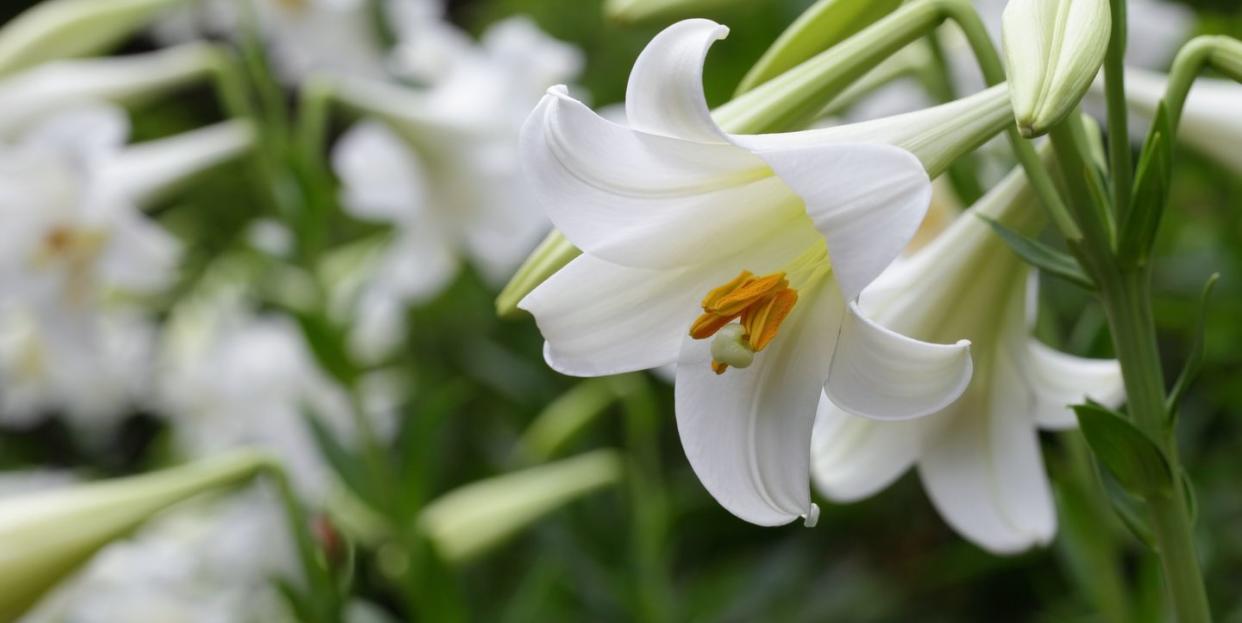The Special Meaning of Easter Lilies

Easter lilies, those gorgeous trumpet-shaped flowers you see this time of year, have a long history. “In the 1700s, a Spanish monk sent to Asia for mission work learned about these plants, which are native to the southern tip of Korea and the islands south of Japan,” says Harry Harms, who was a grower for more than 45 years with Hastings Bulb Growers, Inc., along the Oregon-California border. "The monk carried the lilies with him as he was headed home, but he ultimately disembarked from the ship in Bermuda, where the lily was cultivated."
The connection with Easter occurred when an American florist imported them to the U.S. from Bermuda in the 1880s. "The tradition was to make elaborate floral displays in churches at Easter, and these flowers became increasingly popular to decorate the altar and sanctuary," says professor and Jesuit priest Bruce T. Morrill, PhD, Chair of Catholic Studies at Vanderbilt Divinity School. It's a tradition continued to this day in churches across the country.
While Bermuda and Japan originally provided Easter lilies to the U.S., a drought in Bermuda and the aftermath of Pearl Harbor eliminated those sources. Instead, growers in Oregon, where the plants thrived in the mild coastal climate, began providing bulbs for the American market. Today, Hastings Bulb Growers is one of a handful of remaining family farms which (amazingly!) supply all the Easter lilies grown in the U.S. and Canada.
Whether you’re a beginner gardener or you're a pro looking to add some Easter lilies to your bounty of spring flowers, here's what to know about caring for this seasonal favorite with a symbolic meaning.
Easter lilies symbolize purity.
These flowers, also known by their scientific name Lilium longiforum, are traditionally white or white with faint pink streaks. Many other lily colors do exist—including red, orange, and yellow—but white lilies are the ones customarily displayed for Easter. In addition, white is significant because it's the color worn by clergy, such as Roman Catholics, during the celebration of the liturgy, or official rites, at Easter to celebrate the purity of Jesus's soul.
Lilies have been seen in art and literature as symbols of purity for centuries. According to the Getty Museum, the white lily represented chastity in Renaissance manuscripts. Artists as early as the 1400s depicted lilies alongside the Virgin Mary. Paintings showing the Annunciation often include the Angel Gabriel holding a sheaf of lilies. In the Bible, Jesus is quoted as saying, "Consider the lilies how they grow: they toil not, they spin not; and yet I say unto you, that Solomon in all his glory was not arrayed like one of these.” (Luke 12:27). But interesting note: While lilies are mentioned in the Bible, they're not actually the contemporary Easter lily, but rather lily of the valley, says Morrill.
You don't have to do much to get an Easter lily to bloom.
Incredibly, the bulbs of Easter lilies have to be cultivated for three years in the fields, being tended entirely by hand as they mature, says Harms. Once shipped to nurseries, conditions are strictly controlled so they’ll bloom for Easter, which changes dates every year. Fun aside: Nowadays, almost all Easter lilies available as potted gift plants are a variety called “Nellie White,” named by grower James White after his wife, according to Texas A&M Agrilife Extension.
Because growers use precise horticultural techniques to manipulate temperature and light conditions, “about 95 percent of the time, they’ll bloom in time for Easter with no help from you,” says Harms. Just remember that a cooler room will help the flowers last longer, which means an indoor temperature of about 60 to 65 degrees.
How should I care for my Easter lily?
Choose a plant with no yellow leaves and several flower buds. Keep your lilies out of direct sunlight and away from heating vents. Water with about a cup of water when the soil surface feels dry. If you prefer, remove the yellow-orange pistils in the center of the flower so pollen doesn’t drop and stain furniture or tablecloths; removing these also reduces fragrance, which can be overwhelming to some people, says Harms. They'll typically bloom for about a week to ten days indoors.
You can plant your Easter lily outside after it blooms.
Snap off each flower at its base when it dies. When none remain and the danger of frost is past, pick a spot in full sun in a well-drained area of your garden. In a hot climate, plant the bulb where there’s afternoon shade. Dig a hole, add some compost (here’s how to make your own!), remove the pot, and place the plant at the same depth in the ground as it was in the pot. Water well. Feed it every few months during the growing season with an all-purpose balanced fertilizer. “It won’t look like much is happening throughout the summer, but it’s building the bulb and storing energy for next year,” says Harms.
Easter lilies will multiply in some USDA Hardiness zones.
In USDA Hardiness zone 7 and warmer (check your zone here), your Easter lily has a good chance of coming back for several years. It may even make new baby plants! Generally, it will flower next year in late spring or summer, which is its normal bloom time (not at Easter, when the plants are "forced" into blooming by growers). If you live in a colder climate, there’s certainly no harm in trying to plant lilies in your garden but you likely won’t have much luck as they don’t tolerate extreme cold.
For more ways to live your best life plus all things Oprah, sign up for our newsletter!

